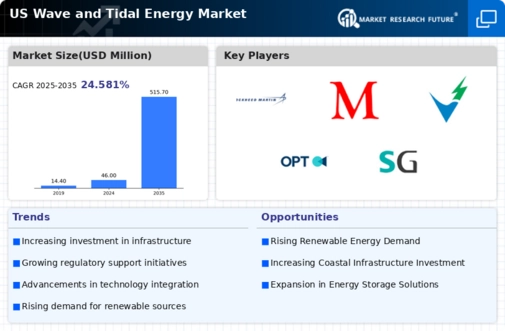Rising Awareness of Energy Security
The wave and-tidal-energy market is increasingly recognized for its potential to enhance energy security in the US. As geopolitical tensions and supply chain disruptions become more prevalent, the need for diverse and reliable energy sources is paramount. Marine energy offers a localized solution that can reduce dependence on imported fossil fuels. The US has vast coastlines and abundant marine resources, which, if harnessed effectively, could provide a substantial portion of the nation's energy needs. Recent studies suggest that wave and tidal energy could contribute up to 15% of the US electricity supply by 2030. This potential for energy independence is likely to drive interest and investment in the wave and-tidal-energy market, as stakeholders seek to mitigate risks associated with traditional energy sources.
Growing Demand for Clean Energy Solutions
The wave and-tidal-energy market is benefiting from an increasing demand for clean energy solutions in the US. As climate change concerns escalate, consumers and businesses alike are seeking sustainable alternatives to fossil fuels. According to recent surveys, approximately 70% of Americans support the transition to renewable energy sources, indicating a strong public sentiment favoring clean energy. This demand is driving policymakers to prioritize renewable energy initiatives, including wave and tidal energy projects. The market's growth is further supported by the rising number of corporate sustainability commitments, with many companies pledging to achieve net-zero emissions by 2050. This trend is likely to create a favorable environment for the wave and-tidal-energy market, as it aligns with broader efforts to reduce carbon footprints and promote environmental stewardship.
Supportive Policy Frameworks and Incentives
The wave and-tidal-energy market is significantly influenced by supportive policy frameworks and incentives established by the US government. Various federal and state policies are designed to promote the development of renewable energy sources, including tax credits, grants, and subsidies. For instance, the Investment Tax Credit (ITC) provides a 30% tax credit for renewable energy investments, which can substantially lower the financial burden on developers. Additionally, states like California and Hawaii have implemented aggressive renewable portfolio standards that mandate a certain percentage of energy to come from renewable sources. These policies not only encourage investment in the wave and-tidal-energy market but also create a more predictable regulatory environment, which is essential for long-term project planning and execution. As these frameworks evolve, they are likely to further stimulate growth in the market.
Investment in Renewable Energy Infrastructure
The wave and-tidal-energy market is experiencing a surge in investment as stakeholders recognize the potential of marine energy sources. In the US, federal and state governments are allocating substantial funds to develop infrastructure that supports renewable energy projects. For instance, the Biden administration has proposed investments exceeding $100 billion in clean energy initiatives, which includes funding for wave and tidal energy projects. This financial backing is crucial for the market's growth, as it enables the construction of necessary facilities and technology development. Furthermore, private sector investments are also increasing, with companies seeking to capitalize on the growing demand for sustainable energy solutions. This influx of capital is likely to enhance the competitiveness of the wave and-tidal-energy market, positioning it as a viable alternative to traditional energy sources.
Technological Innovations in Energy Conversion
Technological advancements play a pivotal role in the wave and-tidal-energy market, particularly in energy conversion systems. Innovations in turbine design and energy capture mechanisms are enhancing efficiency and reducing costs. For example, recent developments in oscillating water column technology have shown promise in increasing energy output by up to 30%. These innovations not only improve the feasibility of wave and tidal energy projects but also attract investment and interest from various stakeholders. As technology continues to evolve, the market is likely to witness a shift towards more efficient and cost-effective solutions, which could lead to a broader adoption of marine energy systems across the US. The ongoing research and development efforts are expected to yield further breakthroughs, potentially transforming the landscape of the wave and-tidal-energy market.
















Leave a Comment